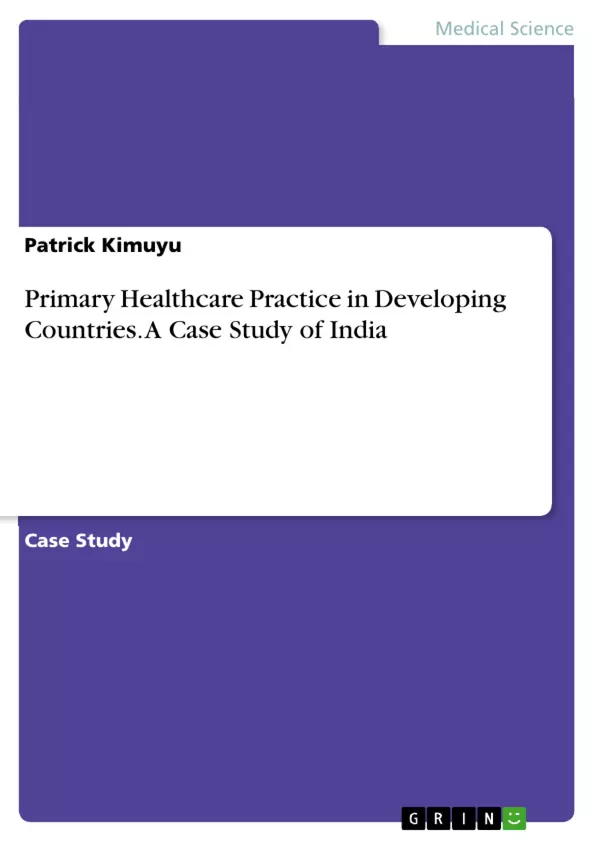Assessing and improving primary healthcare has been an enormous challenge to the Healthcare Systems of developing countries around the globe. Therefore, lack of adequate healthcare services in most developing countries is believed to be the principal cause of short life-expectancy, owing to the high rates of mortality. In most developing countries, especially in Africa and Asia, policy makers and technical agencies do not seem to give primary healthcare high priority, and this is probably the reason as to why healthcare standards in these countries have remained low, despite the immense efforts of the International community. Moreover, most healthcare national programmes, which are initiated in developing countries to abase the public healthcare challenge, do not achieve remarkable success.
One of the most significant factors which seem to have worsened the issue is the rapid expansion of the populations within the developing countries. It has been found that developing countries have the highest population growth rate compared to the wealthier nations such as the United Kingdom, Australia and the United States of America.
This phenomenon explains why healthcare influence development in developing countries. A healthy population plays a pivotal role in establishing a healthy economy of any country. However, it is worth noting that, the correlation between the progress of healthcare and national development follows diverse trends. For instance, change in demographic trends causes pressure on the existing public healthcare systems.
Therefore, this research will give an overview on the concept of development and its links to health in India.
Inhaltsverzeichnis (Table of Contents)
- Introduction
- India's Demographic and Epidemiological Profile
- India's Demographic Profile
- India's Demographic Transition and its Consequences for Development
- India's Epidemiological Profile
- Burden of Disease
- India's Epidemiological Transition and its Consequences to Development
- India's Epidemiological Trends Compared to Australia
- India's Development Prospects and Its Impact on Health
- Conclusion
Zielsetzung und Themenschwerpunkte (Objectives and Key Themes)
This research aims to provide an overview of the concept of development and its links to health in India, focusing on the country's demographic and epidemiological profiles. The study analyzes how these factors impact healthcare systems and national development.
- The impact of demographic trends on India's healthcare systems.
- The influence of epidemiological patterns on national development.
- The burden of disease in India and its implications.
- The role of healthcare in fostering economic growth and a healthy population.
- The correlation between healthcare progress and national development in India.
Zusammenfassung der Kapitel (Chapter Summaries)
- Introduction: This chapter explores the challenges of improving primary healthcare in developing countries, highlighting the link between inadequate healthcare and low life expectancy. The chapter discusses the importance of prioritizing primary healthcare and the impact of population growth on healthcare systems in developing nations.
- India's Demographic and Epidemiological Profile: This chapter examines the demographic and epidemiological trends in India, highlighting the impact of population dynamics on the country's healthcare system. It analyzes factors such as infant mortality, population growth, and the expansion of the working-age population.
- India's Demographic Profile: This chapter delves into the specifics of India's demographic profile, analyzing population dynamics and their impact on economic growth. It discusses the demographic transition in India, including the decline of infant and child mortality and the expansion of the working-age population.
- India's Demographic Transition and its Consequences for Development: This chapter explores the consequences of India's demographic transition for national development. It examines the impact of declining mortality rates and increasing life expectancy on population growth and the subsequent strain on healthcare systems.
- India's Epidemiological Profile: This chapter focuses on India's health profile, analyzing trends in nutrition, health status, and the burden of disease. It explores the shift from communicable diseases to noncommunicable diseases such as cancer, diabetes, and heart failure.
- Burden of Disease: This chapter explains the concept of burden of disease and how it is measured. It discusses the significant burden of disease in India, highlighting the country's position in the global ranking for Daily Adjusted Life Years (DALY) losses.
Schlüsselwörter (Keywords)
This research focuses on primary healthcare, developing countries, India, demographic transition, epidemiological trends, burden of disease, healthcare systems, national development, economic growth, population dynamics, infant mortality, working-age population, and health status.
- Quote paper
- Patrick Kimuyu (Author), 2017, Primary Healthcare Practice in Developing Countries. A Case Study of India, Munich, GRIN Verlag, https://www.grin.com/document/380745



